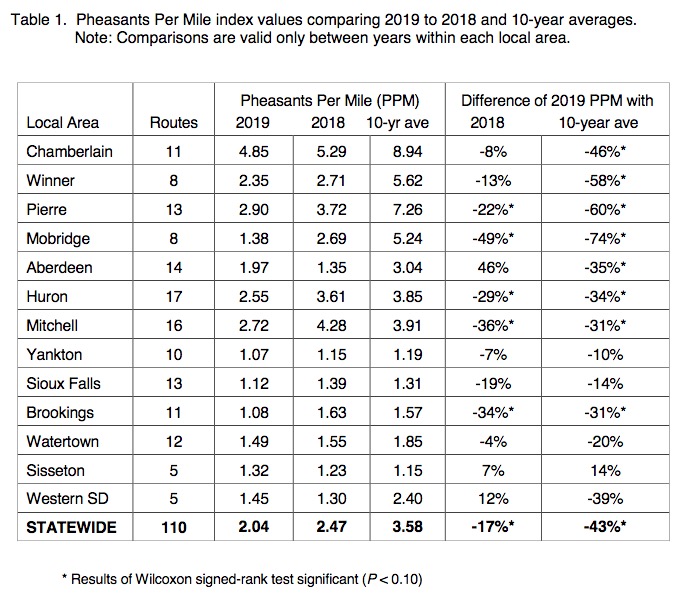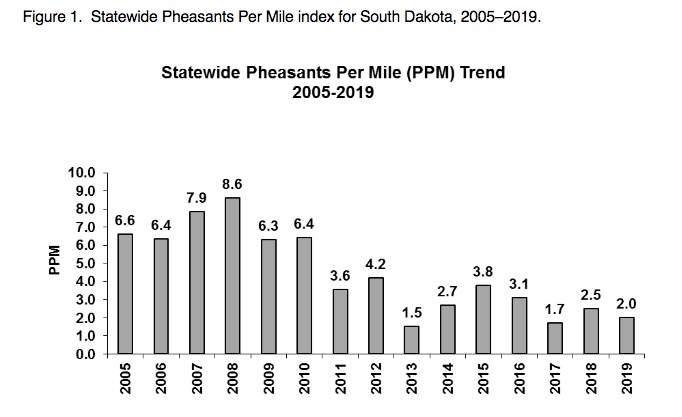The 2019 Pheasant Brood Survey shows exactly what every reasonable scientific observer and Game Fish and Parks’s own experts predicted: no sign of any boost in pheasant populations from Governor Kristi Noem’s trap-o-rama. Game Fish and Parks personnel counted fewer pheasants per mile than last year everywhere but around Sisseton and Aberdeen and out in most of West River:

GF&P counted fewer pheasants in 2013 and 2017, but numbers remain awful compared to the first decade of this century:

The Pheasant Brood Survey does not mention trapping or predators once, but Game Fish and Parks speaks unequivocally about the primary cause of the long-term decline in pheasant population—habitat loss due to farms gobbling up grassland:
Last year we celebrated the 100thpheasant season in South Dakota and for the first time since 1990, total harvest was below 1 million roosters for two years in a row.In fact, harvest in 2007 (2.1 million) was higher than the last two years combined (1.8 million). As we celebrate 100 years of pheasant hunting, it is also important to acknowledge the steady decade-long decline in PPM is likely related to upland habitat loss. Lands enrolled in the Conservation Reserve Program (CRP) represent the premium nesting habitat in the state and have declined by 35% or 553,000 acres since 2007 (Figure5). The combined availability ofhayland, small grains, and CRP has declined by 46% or 5.5 million acres since 1990 (Figure 6). This represents an average monthly loss of 15,690acres, or an area twice as big as Lake Poinsett,for the past 29years. During the 15-year period of 1982–1997, 1.82 million acres of grassland were converted to cropland (U.S. GAO 2007). A more recent study found 1.84 million acres of grassland were lost, primarily to conversion to cropland, from 2006–2012 (Reitsma et al.2014). Environmental conditions will always contribute heavily to year to year changes in pheasant abundance, but the long term erosion of required habitat will undoubtedly result in lower lows and lower highs [Runia/GF&P, 2019.09.05].
GF&P also reports that this year’s numbers were expected to be low due to the hard winter and wet spring, but that brood size benefited from the “lush habitat conditions” created by all that moisture:
The observed slight decline in the overall pheasant population index was expected given the historic winter snowfall and spring/summer precipitation patterns.Even with very unfavorable weather conditions, the PPM index remained nearly unchanged (less than15%decrease or increase)from last year for 7 of the 13local areas.In addition, it is highly likely that flooded ditches and unplanted crop fields reduced the number of pheasants using roadside habitat thus reducing the number of pheasants observed in 2019 compared to 2018. The resiliency of pheasants was tested as December through April precipitation was essentially all snow,the 4thhighest on record,and the highest since 1985-86 (Figure 4). Multiple major blizzards pounded the state with extraordinary events occurring in March and April. May through July precipitation was the 5thhighest on record and the highest since 1993(Figure 4). Roadside counts commonly decline following harsh winters, likely in response to a decline in adult survival. May through July represents the primary nesting and brood-rearing season. The cool and wet weather could have delayed and subsequently shortened the nesting season. Many nests in low lying upland habitat were likely inundated during flooding rains. Brood-rearing success can be directly suppressed by heavy rains, but the respectable average brood size observed this year suggests lush habitat conditions may have compensated for otherwise challenging environmental conditions [Runia/GF&P, 2019.09.05].
Any policymaker reading this report for guidance on pro-life pheasant policy would conclude that we need to go on an environmental binge of habitat restoration: double the tax break for and triple the width of riparian buffer strips; tax the removal of shelterbelts; require acre-to-acre replacement of any shelterbelts, grassland, or wetland converted to crop production; and expand state buy-out programs to protect uncultivated land and expand public hunting areas. But given Kristi Noem’s Trumpist preference for image over science, she’ll probably just come out with a plan to kill more critters.
Can someone explain the appeal of gunning pheasants just because? I hunted them for 30 years and never once claimed a three bird daily limit.
Wonder if the pheasants could thirve in the hemp ? Hmmm …..
Mike, I enjoyed the challenge of hitting them because they’re so fast. We always tried to fill our limits because the birds helped fill our freezer.
Maybe we could make them more of a tourist attraction…yeah, that’s the ticket. What’s the difference between a chicken and a pheasant? Chicken tastes better.
https://www.youtube.com/watch?v=AmHImv58_Qg
its all commercial hunting any more and all the birds are hauled in the guide services could give a rip about brood counts,, they will never have a bad season count on it.. and basically its just a booze and women season anymore
Richard, what’s the “booze and women season” part? Is there a lot of prostitution or sex trafficking in SD during pheasant season? If that’s the case, is it widespread?
I could certainly see Debbo’s scenario play out at private resorts of an evening. Just to keep the hunters happy and virile for the next day’s slaughter. What could be more natural than the urge to kill, fornicate and consume alcohol. Get your money’s worth.
I have seen some alleged hunters so enamored with the passion to kill they practically dry humped their weapons just to release some tension. Not people I would care to be hunting in the same county with.
Let them shoot chickens. Why all the drama over a domesticated chicken from China?